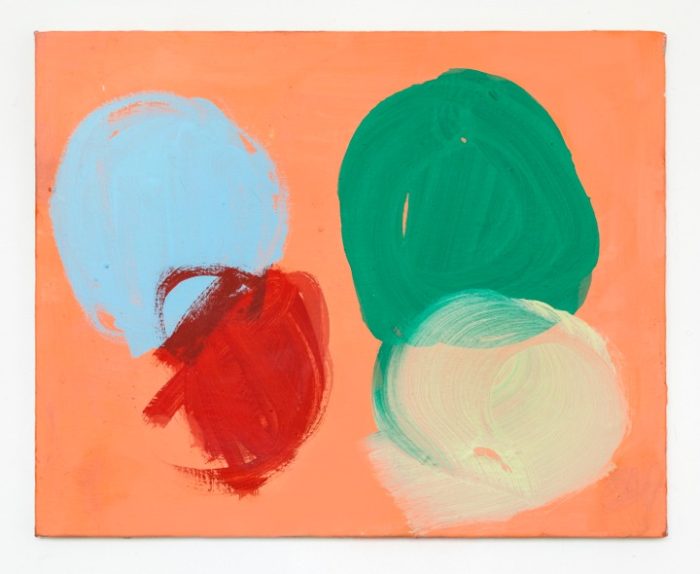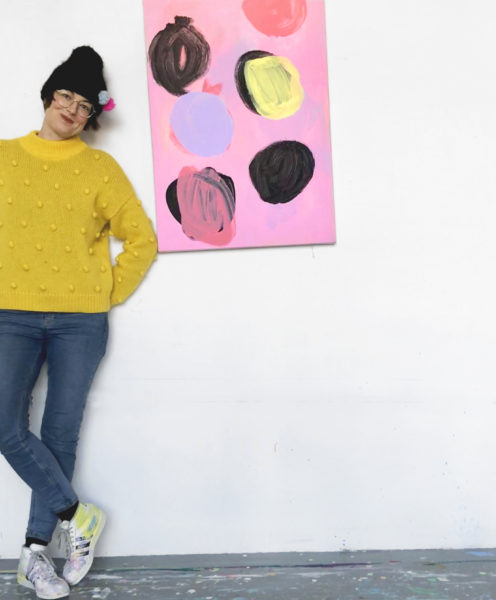
Thanks for having me over your studio in Bushwick. I always cherish the opportunity to see new work. We met a couple of months ago at the dinner for the group show “Alleviators” which was shown at Charles Moffett Gallery. I’m glad we got to sit close to each other so we could meet. Can you talk about your background in the arts and your journey to becoming an artist in New York?
Yes, I’m happy we met and what a surprise to find out we work in the same building. After graduating from Hunter College last spring, I was just about to move into my new studio on 56 Bogart Street where your gallery is located.
Life’s full of surprises. – This could be just the answer to the question of how I became an artist in New York.
Two things happened that seemed impossible to even imagine: To ever go back to art school after graduating at Kunstakademie Düsseldorf and to leave our wonderful apartment in Germany. I did both and more for New York.
I think my case is classic. I always felt drawn to American Art, particularly the New York School and its following generation … even though it took me a long time to come here … once I literally set my foot out of the subway, I knew that I wanted to stay. (It was on 23rd Street and my first impression was the Dallas Diner, people drinking out of these huge bowls. Everything is so big here, even the milk containers — still working on how to prevent it from getting sour… how do Americans manage to drink so much milk?) Anyway, ascending out of this first subway ride had a tremendous impact, from that moment on everything changed: New York became so real.
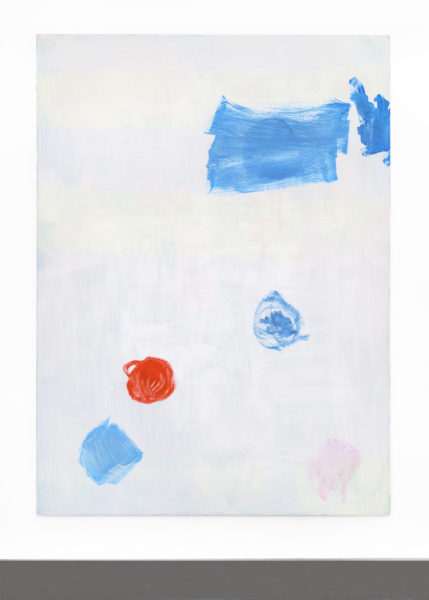
I’ve always been fascinated and felt more drawn to the American approach of painting than the European or German history. I started to paint at 16, inspired by a wild mixture — but as it occurred to me later, solely American artists: De Kooning, Twombly, and Warhol. Later on, I discovered Mary Heilmann and Agnes Martin. All of them are still relevant to my work. Heilmann and Martin fascinate me because of their reductive but thereby emotional and/or personal derivation of their works. The possibility of a travel grant allowed me to explore the areas of New Mexico where Martin has lived. From here I took the ride down to Marfa/ Texas and visited Donald Judd’s living and working environment. To me, there is a connection between vast landscapes and the freedom I find in the American approach. So inspiring for me to be in this environment. Maybe my escape from “too“ much history and tradition. My paintings are experimental spaces. And, although I cannot deny my academic education, the sensual experience remains my vehicle. I like, that everything here seems to vibrate. Painting looks more charged to me, music rocks and I feel at home. I understood what home is.
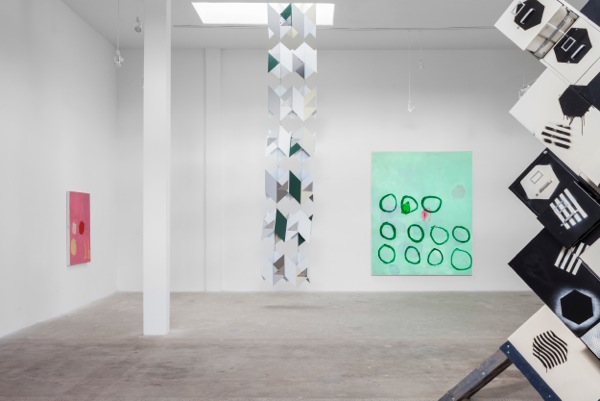
Glad you are feeling at home here. New York is the best. Congratulations on your two-person show Phase Patterns with Jason Meadows at ltd los angeles. Can you tell me more about your process and the paintings that will be shown there?
So excited! It’s my second show with them, and in a way, this show connects to the previous group show this past fall. “If I go there I won’t stay there” featured positions of open modes of art, which relates to my approach of painting as a living space. It’s a floating form that develops over layers of lived experience. On one hand, the picture plane bears witness of that process. But on the other hand, my layering is a process of filtering. In my own way, I want to push the artwork to such an extent that it asks about its existence, as I do about my own. Any artwork I do includes living to filter the process of making toward a final image.
The body for the upcoming show is my first work after graduating. Interestingly (or surprisingly) I didn’t really experience a moment of confusion or feeling abandoned after that time of being educated at school. Being able to move right into a new studio kept me in the flow.
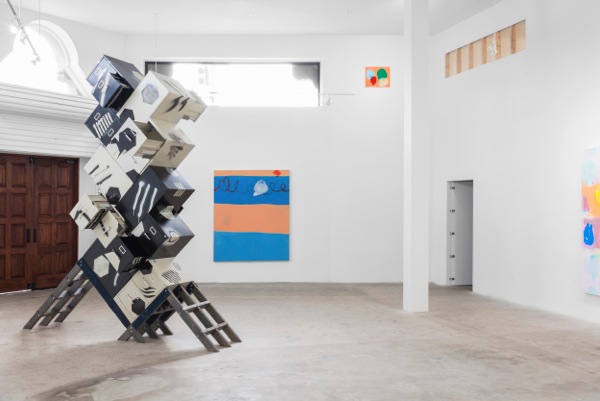
I think my new work is more liberated: Offensive through an even more determined simplicity and openness. My already very limited set of tools got even more reduced. Except one, all paintings turned out to have one plain colored ground on which the marks are placed. In contrast to previous works, color is more saturated and contrasts from the ground to the marks more developed.
Accordingly, the mark making has run through a process of simplification. Circle like splotches, still my preferred motion, occur more promptly. Their brushstroke is visible and a bit wild. To me these works speak a more direct language — the painting comes to life through its purity.
Reduction and openness together is a challenge, in my work they can only live together if I put the risk to fail above the concept. My work is an ongoing discovery nurtured from spontaneity and authenticity. Painting, a seismographic motion to my life. Sometimes a navigator. Questioning comes before explaining. Any painting is stepping in the unknown and trying to … how to say that … figuring it out. I start any painting by jumping in a blank openness.

Questions are always better than answers. What kind of things are influencing your work right now?
In preparation for the show Phase Patterns, ltd los angeles and I talked intensely about my working process. It’s hovering between openness and simplicity is quite a dialectic movement. The image evolves through adding and taking away. We went deep in our conversation, tracing the path where a work ends and when it begins: this became the central question for the show.
I am very interested in physics, particularly quantum physics and the desire of many scientists, as Stephen Hawking puts it, to “find the one formula that explains everything.” We came along that my process reminds on finding a language or formula for a certain state of mind. In a way I see myself as a researcher, I like the term “cosmologist” Hawking used for himself. Life itself is such a big surprise to me.
“How can this all be?” has been a question to me ever since. At about seven years old I remember lying on the backseat of the car, my mum was driving, I was looking in the sky and asking her: ”What is behind this blue?”
I think that color on one hand and numbers on the other, or simply the mere rhythm of counting are the two major components of my new recent works.
I see influences of my father, who was a mathematician. He seemed to live in numbers and liked to communicate with me through quotations and chess. Long walks, where we maintained a conversation ping-ponging only multiplication tables. This is probably when I started to connect emotions to numbers and abstract patterns.
Reading “Eye and Mind” by Maurice Merleau-Ponty has had and still has an impact on me. I see his phenomenological approach related to my painting practice. Especially the way Merleau- Ponty describes “seeing” as having the potential for meaning-making. By embracing presence and discoveries Merleau-Ponty emphasizes a process of visualizing that he describes as “rather than seeing it I see according to.” The act of seeing is characterized as an external and internal motion. I associate this with my described seismographic mode.
All my paintings are textures that require living. Every mark is imbued with personal experience; they are emotional landscapes or “textures of the real” (Merleau-Ponty).
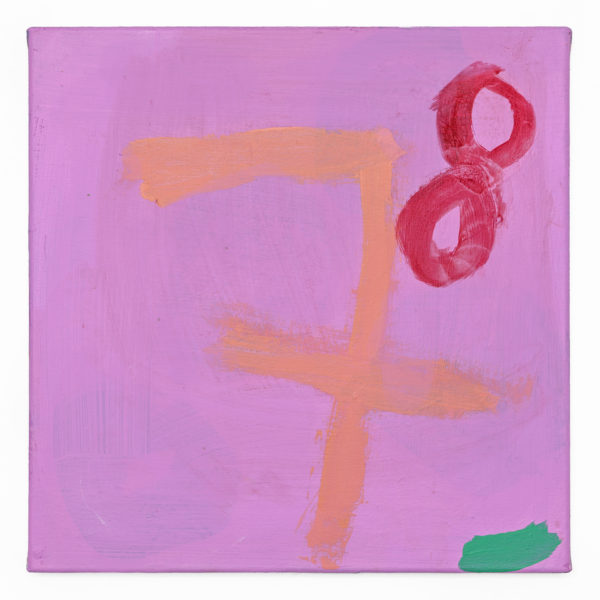
I’m also a big fan of Quantum Physics. We’ll have to talk more about that in person. I admire your use of color in the paintings you are showing at ltd los angeles. Can you elaborate on your relationship with color?
Oh, thank you! Color is so important to me. I probably have a personal relationship to each color as such makes me very happy, an elixir for living. The mere application of paint is something I don’t want to miss for too long.
I prefer simple hard fiber brushes (hardware supplies included), some extended on sticks (that’s how I can reach all over my large sizes since I prefer lying the canvas on the ground) and water-based, rich pigmented paint. I work in layers by applying fast and choosing color intuitively. My palette is idiosyncratic. I don’t mix much. I want pure tones, usually, they get little whitened.
Although this process might sound blunt on the first glance, it is a refined, pure and precise action. I want the surface to be matte and a little textured. My paintings are palpable records of their own making, open textures.
My matte surfaces are inspired by Italian Renaissance’s frescos, in particular, Fra Angelico‘s series in the cloister of San Marco in Florence. I like how the paint fuses with the wall and creates this particular whitish matte finish — to me, this allows the color to unfold. There’s no distraction, such as gloss or too much excitement of stark color contrast. A calm joy. The painting just is. It can do both, reach out very far and come intimately close.
I also experiment with the process of layering in some aspects inspired by Italian Renaissance painting. I use light and dark as well as complemental contrast in between layers, so the painting incorporates a glow as if the light would come from inside. I’m seeking an ambient character — a presence you can decide whether passing by or engaging with. I hope that there’s freedom in my color.
And, lastly, of course, there’s to mention Agnes Martin’s color – I love very much. Highly diluted as it is, just to the extent that makes the painting come and go. There’s light; evolving through a very puristic and simple application of color. They are elusive as much they are steady. So much space to breath.
Maybe this is what makes a painting, what allows the painting to live and also grow … so fascinating. – I think color lives.
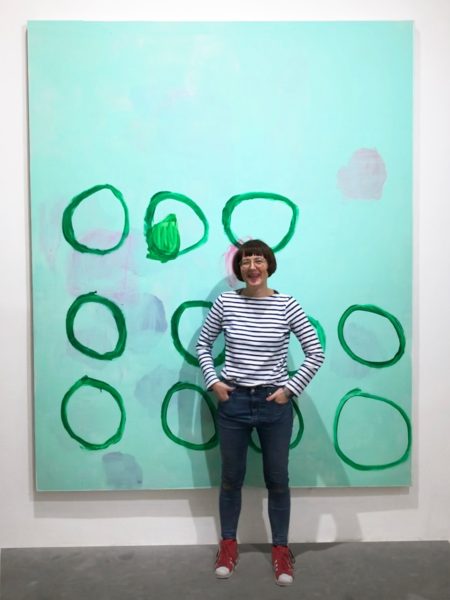
Do you have any other projects or shows coming up?
Yes, quite a bit in planning; some shows and book projects. One is an artist book featuring my drawings with Puppy American. Another is with Hammann von Mier Publishing. They included me in „Form your Character“, a collection of interviews with female artists. I am working on a new sound piece. And, I’ll be back to Los Angeles for an artist talk with Terry R. Myers on February 23 at ltd los angeles. – wild times, really like it.
